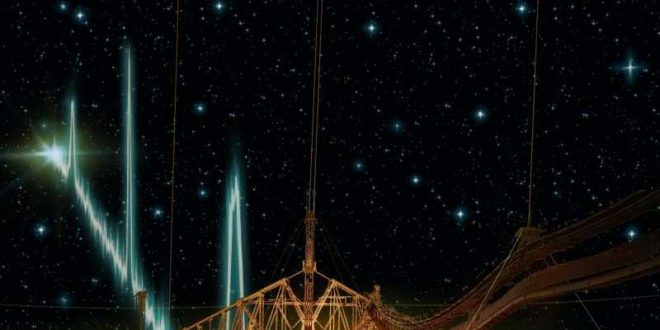Mysterious signals called fast radio bursts (FRB) are from deep space and could be evidence of advanced alien technology, according to a study Australian scientists published Monday.
FRBs are short, bright and highly dispersed pulses of radio waves that occur randomly. They typically last just a few milliseconds but register about a billion times brighter than anything ever observed in the galaxy.
Since they were first detected almost 10 years ago by the Parkes radio telescope in New South Wales, these enigmatic radio transients have perplexed astronomers. While they appeared to come from vast distances, their was still a possibility that their origin was closer to home. Were they signals from far-off galaxies or simply some unknown form of local interference?
Now, thanks to the extensive upgrade of the Molonglo Observatory Synthesis Telescope (MOST), located about 350 km south of Parkes near Canberra, there is a definitive answer. In a paper to be published in Monthly Notices of the Royal Astronomical Society, a research team from Australian National University, Swinburne University of Technology, University of Sydney and the ARC Centre of Excellence for All-sky Astrophysics (CAASTRO), has confirmed the FRBs do in fact originate from outer space and – in some cases, at least – from galaxies beyond the Milky Way.
The research team, headed by PhD candidate and first author Manisha Caleb, has successfully identified the origin of three distinct FRBs.
The use of the updated Molonglo telescope (UTMOST) – a 778-metre-long parabolic cylindrical antenna array comprising a total of 352 independent antennae, with 7,744 ring antennae at the focus of the parabola – overcomes the limitations of the single-dish radio telescopes such as Parkes that initially detected FRBs as one-off events.
“Single-dish antennas have difficulty establishing that transmissions originate beyond Earth’s atmosphere,” explains researcher Dr Chris Flynn of Swinburne’s Centre for Astrophysics and Supercomputing.
The Molongo antennae’s enormous focal length, however, has enabled researchers to use the technique of interferometric detection to calculate the minimum distance of FRBs.
The UTMOST project has been led by the director of Swinburne’s centre, Professor Matthew Bailes, following recognition back in 2013 of the potential of the 50-year-old synthesis telescope to help pinpoint the source of FRBs.
The upgrade involved fitting the telescope with a new supercomputer system enabling observations to be viewed in real time and the colossal 1,000 terabytes of data produced daily to be sifted and processed.
Caleb, who led the work developing software to do that sifting, explains that UTMOST detects only events more than 10,000 km away, thereby ruling out terrestrial sources of interference as an origin for FRBs.
“The telescope has literally been reborn and transformed exclusively to search for these Fast Radio Bursts,” she says. “We have scientifically confirmed that FRB’s are extra-terrestrial.”
With funding from the Australian Research Council (ARC), the Molonglo telescope will upgraded over the next two years to enable the localisation of FRBs to individual galaxies.
“Figuring out where the bursts come from is the key to understanding what makes them,” Caleb says. “Only one burst has been linked to a specific galaxy.”
That burst, identified by the Arecibo Observatory in Puerto Rico, was only able to be localised as the only FRB known to have been repeated. In future UTMOST should be able to identify the host galaxy of a burst without repeat events.
“We expect Molonglo will do this for many more bursts,” Caleb says.
Agencies/Canadajournal
 Canada Journal – News of the World Articles and videos to bring you the biggest Canadian news stories from across the country every day
Canada Journal – News of the World Articles and videos to bring you the biggest Canadian news stories from across the country every day



